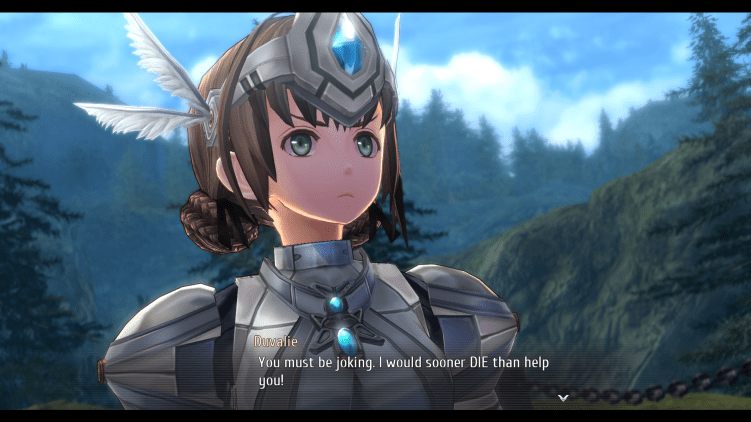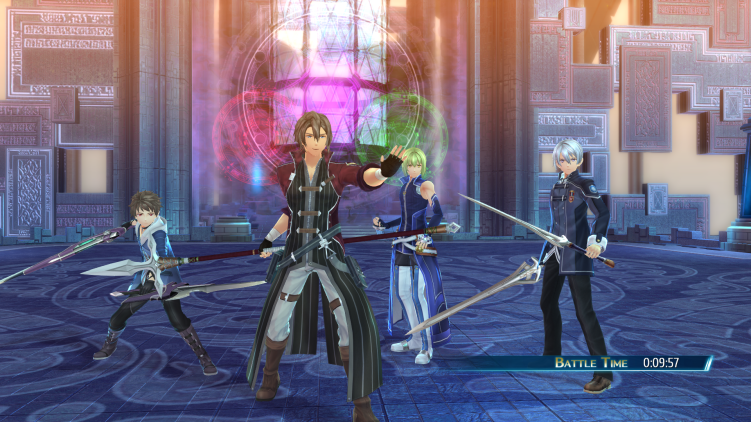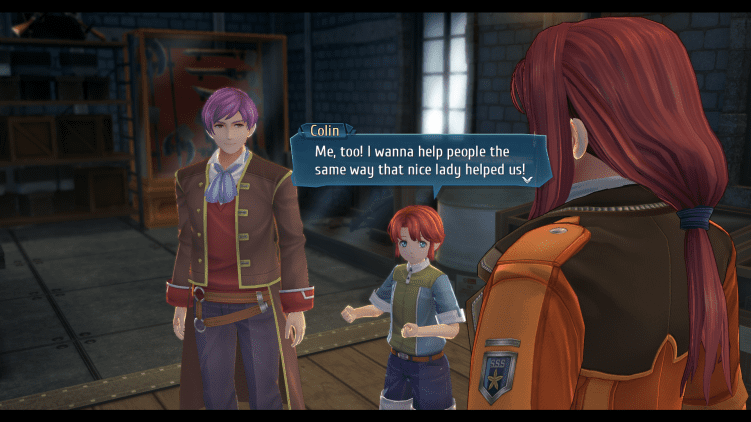After a whole host of games following the exploits of the Special Support Section and Class VII culminated in Trails of Cold Steel IV, it seemed like the story of Trails was ready to forge ahead into a brand new chapter, especially seeing as we’re already over the series’ supposed halfway mark. However it would appear that the team wasn’t ready to leave behind Erebonia and Crossbell just yet, as today’s title sought to be one last hurrah for the many characters and locations of the past six games. Said past games have undoubtedly had both staggering highs and crushing lows, but where could this strange little addendum rank amongst them all? Such is the question we are investigating today, coming to you after another 45 hour foray into western Zemuria!

Developed by Nihon Falcom, published by NIS America, and released on July 7th 2023, The Legend of Heroes: Trails into Reverie is an anime role playing game available for PC, PS4, PS5, and Nintendo Switch. Its premise involves three protagonists undertaking various journeys that ultimately weave together in a climactic confrontation for the fate of their world once more. Players interact with the game through area and dungeon exploration, positional turn-based combat, character customization in the menus, various minigames, and a LOT of reading. Please note that the PC version of the game was used for this review.
As usual, allow me to begin by contextualizing this game with regards to the wider Trails series. Trails into Reverie is the 10th entry into the long running JRPG series, and despite its name having no similarity to any previous title outside of the series greater name it is something of an epilogue for the Crossbell duology (Zero and Azure) and the Cold Steel quadrilogy. If that sounds like you must play a lot of other games just to enjoy this one… that’s because you kinda have to. Obviously I’m not saying you cannot play this game without playing the others, as I myself have willfully played further into the Trails timeline than I was supposed to myself, but here more than anywhere else I should at least warn you that the game expects your knowledge of previous games to do a lot of legwork here. The game has text-based summaries of the other titles to get the bold caught up if you are determined, but obviously don’t expect it to be a true substitute. I’m honestly not sure if there will ever be another game like this one in terms of the sheer amount of other games it technically asks you to play before jumping in, it’s crazy! Also I will be allowing myself to spoil things from previous Trails games if I need it for the analysis, although I’ll try to be measured in what I give away.
Trails into Reverie begins with an action packed return to Orchis Tower in Crossbell as the Special Support Section, alongside the visiting Juna Crawford, do battle against an armed group of holdouts unable to let go of the unceremonious end of Operation Jormungandr five months ago. The team prevails in keeping the spark of war from igniting once again, but it is ominously revealed that someone at another location has been monitoring the whole situation as they initiate a new plan from their terminal: Project Babel. From here the game picks up a month later and follows the perspectives of three principal characters: the two returning protagonists Lloyd Bannings and Rean Schwarzer, as well as an enigmatic new protagonist appropriating the alias of former antagonist C.
Perhaps the most interesting innovation that the narrative of Reverie brings is its Trails to Walk system, as these three perspectives are not played in a set sequence. You do have certain checks in place to ensure you don’t play too far in any one route without making progress in another, but otherwise you are free to shift points of view with the press of a button. This gives the game the most unique structure and pacing in the series thus far, and while I’m not sure if I want it to return per se since I’d prefer singular protagonists, it’s a very interesting system nonetheless. I just wish that the story it was telling was… actually good? Sorry everyone but I cannot lie: the narrative here was not worth another full release for. The Lloyd and Rean routes redo a staggering amount of material from their previous outings, Azure and Cold Steel IV especially, and they’re so crowded with characters that almost nobody gets any development, just a bunch of reaffirmations that add little. My boy Kurt gets a moment in the sun during chapter one of Rean’s route to more fully payoff his character arc from Cold Steel III, and that’s pretty much it for developing the characters of the first two routes’ cast. The C route serves as something of a saving grace for the game’s story as it heavily features some new characters that are pretty great and keeps its group tightly knit, although even it has some major issues. Case and point: the protagonist C is actually a character I had always felt there was more to say about beneath the mask and I’m really happy he got a chance to play a larger role, but the vast majority of his development is catalyzed by his relationship to Lapis Rosenburg, one of the worst characters in the whole series, and the game REALLY wraps his characterization around her.

The overarching plot tying all of this together really doesn’t help either. Everything about the setup is so utterly contrived and underdeveloped that I simply can’t accept that most of the story happened for any other reason than for the developers to parade around ideas that were already popular or that they were proud of. The main villain’s entire existence hinges on a piece of technology spontaneously appearing for crying out loud! And as a final nail in the coffin, the game features a sort of meta-dungeon which players can access at any time in order to unlock side-stories similar to the doors in Sky the 3rd called the True Reverie Corridor, and it’s justified in the narrative as all of the main characters having artifacts that let them teleport in at any time, but going there suppresses their memories of recent events, and leaving it suppresses any recollection of what happens in the Corridor. It is as stupid and absurd as it sounds and I actively avoided going there until the post-game. Ultimately the story of Trails into Reverie might just be the worst in the entire series and weirdly not because it actively makes me mad like some of the other games. Those games whose stories upset me at least were interesting enough in their own right to make me feel something about them, but here all I felt was a sense of milquetoast repetition which robs the tale of even ironic entertainment. I do respect how the large scale of the cast and the three perspective system tries to capture the purest essence of the Trails series and its ideas of how one journey is a part of many others, but that alone isn’t nearly enough to make up for everything else.
When we move over to the gameplay side of things however, things are thankfully better. If you’ve played Trails of Cold Steel IV then you pretty much know what to expect, however the very same Trails to Walk system which is emblematic of many of the problems with Reverie’s story also epitomizes its greatest strengths in gameplay. Combat and dungeon design is very similar to previous entries with the main new feature being the United Front maneuvers which allow you to spend your assault gauges to unleash absurd damage or healing. There’s no disguising just how unbalanced this game is when considering all of the other crazy mechanics available to the player like Sub-Master quartz, the break gauge, triple advantage, link attacks, etc. However I did find the game’s combat to be relatively more engaging than Cold Steel IV thanks to a few key balance changes to certain quartz forcing me to get more creative with my builds. More importantly is the fact that we have three parties to playthrough concurrently, which ensures you are constantly switching to different sets of characters which require different play patterns to optimize, especially in the Lloyd and Rean routes where the selection within each party changes rapidly to account for all the character bloat. I can admit without shame that I play most of the Trails series by finding the four characters I want to use and mostly just leveraging them the whole time, but this entry has definitely reminded me how much fun it is to strategize around different fighter combinations. With well over 40 different playable characters in the game you’re going to try out a LOT of tools!
The positive effects of the Trails to Walk system extend to exploration design as well. In certain dungeons later in the game you have a gimmick where buttons must be pressed by two of the protagonist groups simultaneously in order for both to progress, and this feels like a smart evolution of the few multi-party dungeons from previous entries. Mainly because the design of Trails into Reverie as a whole actively minimizes punishment for relying on an A-team, but I digress. This system does cut down a lot on the amount of NPC dialogue and world exploration the series is known for since the chapters are so objective based, but considering everything else this game has crammed into it I don’t blame Falcom for giving themselves a bit of a break. Most of ‘everything else’ being in the True Reverie Corridor, which despite its narrative nonsense turns out to give this title the rare honor of being an RPG with a proper post-game. The dungeon inside the Corridor is randomly generated and can be reshuffled at any time from its hub so you can dive in again and again to collect treasures to redeem for extra side story content, a wealth of minigames, and even extra playable characters who didn’t make the cut for the main story. The minigames are perhaps not the game’s strong suit as many of them come across as fanservice-y in a kind of pervy way (there is LITERALLY a beach minigame which has VR compatibility), but the other rewards are satisfying to get more of and actively make me want to go back in to the game despite the credits having rolled. All Trails games are arguably quite content rich, but Reverie does a uniquely great job incentivising you to engage with as much of it as possible.

As for the game’s presentation, changes from before are small but impactful. For the most part the game is a complete graphical port of the two titles that preceded it. As I stated in the review of those outings, I loved the combat animations in them but felt that character animation was still a bit stiff. Everything there is still more or less true for Reverie, but for a number of important story scenes the team employed a new in-house game engine to bring more cinematic and dynamic presentation. These cutscenes were a little sparse but very impressive to watch and it makes me excited to see where future installments take the new tech. I’d also like to give a quick shout out to the two remastered areas they included here, as while the sections were brief, it was great seeing Ymir and Nord again in explorable forms. The game may not be the most graphically impressive, but it’s moving in the right direction. The music of Trails into Reverie also makes a strong showing. While I don’t think it quite matches the Cold Steel quadrilogy in quality since what music they do reuse from it wasn’t the previous arc’s best tracks, the new compositions carve out a distinct and satisfying identity for themselves. Granted there is a lot of synthetics in the soundscape that I wish there were less of, but some of the heavier battle tracks make up for it. The main battle themes and the boss theme Emergency Order stand out in this regard.
Lastly, as far as wisdom from this game is concerned… it seems to be an opportunity for clarification rather than positive endorsement of the game’s messaging. A large theme in C’s route centers around what it means to be human and what circumstances of life can or cannot affect that status. This is all well and good, but the thesis the game chooses for its exploration is delivered by Lapis as “Being is what makes a human a human.” Anyone with a drop of philosophical background like myself will immediately recognize this definition of humanity as leading directly to the idea that anything with the quality of “being”, which is to say mere existence, is therefore human. So I guess in this JRPG series where almost nobody ever dies, we are still definable as mass murderers because all of the monsters we slay are human since they have being too, huh? Many Trails fans might object and say that this observation is against the spirit of what that scene and the story overall is trying to convey, but to them I would like to recall that later in the game we see this assertion wielded before our very eyes as C uses it to grant humanity to the non-human Lapis, albeit less from a direct assertion of the principle and more from a silly appeal to uncertainty regarding the soul.
Make no mistake, it is satisfying to watch the various characters of C’s crew (sans Lapis) claim their right to human dignity despite their pasts. In a way their sentiments relate back to how Christ’s promise of salvation is efficacious for all sinners regardless of their previous mistakes. But these are observations which I feel that I as a player bring to the story, not something Trails into Reverie is capable of really saying on its own. The foundation here just really is that flawed. Many stories of our age have and will continue to wrestle with the definition of humanity, especially those with technological themes like Trails, but it’s clear to see the effects of our culture’s rejection of traditional wisdom on the matter has plunged us into a great confusion about what humanity even is. Even something as simple as Aristotle’s definition of human, the rational animal, can serve as an incredibly sensible starting point to understanding this question, but far too often do we fixate on the rational part and ascribe humanity to much that does not deserve it (in fiction at least). I encourage anyone without much serious study of this topic to learn more about it, especially the Church’s teaching, because this discussion is getting more important by the day. Every human has a right to their dignity, but don’t let an anime doll tutor you on the subject. Today it’s a goofy game making melodramatic assertions to give its characters a happy ending at all costs, but tomorrow it could be transhuman self-oblivion.
So in conclusion, I have… weird feelings on Trails into Reverie. The main draw of the series in its story buckles under the weight of trying to follow-up two completely finished story arcs, and I would be hard-pressed to see this game’s main narrative matter at all in future entries. However many of the elements which make its writing awful give the gameplay variety and a fun factor which few games in the series have reached, even if it is still a relatively easy system to break. My final prescription on this one is that the vast majority of people simply will not get anything out of this game at all, but if you do happen to fall into the undoubtedly narrow subset of players who have played all six games leading up to this one then there is quite a bit of dumb fun to be had amidst its chaos. If you can get it on sale, you may find more to enjoy here mechanically than you might expect. Though if you belong to the game’s target audience, you probably already bought this day one like me… Oh well.

Scoring: 68%
Gameplay: 4/5
Story: 1/5
Art and Graphics: 4/5
Music: 4/5
Replayability: 4/5
Morality and Parental Warnings
Trails into Reverie features a variety of elements from the series as a whole that are worth being advised on. The majority of magic in the game is actually something of a technological feat, being used for both powering various machines and releasing elemental blasts in combat. There are characters who are specified to be witches who can use ‘real magic’, who once or twice speak out incantations in latin. The main religion in the game is fictional, but features Catholic elements prominently in its architectural inspirations. Certain enemies, locations, and attacks derive their names from various mythologies but this is a more nominal connection than anything. Even the robot with the attack “Satanic Claw” doesn’t really have deeper meaning to it. One of the game’s major plot points is pushed forward through an appeal to uncertainty regarding the soul. Combat generally features a variety of melee weapons, guns, and spells, but blood is not drawn except for a few specific attacks. Monsters run the gambit from fairly innocuous critters to demon-esque abominations.
Most of the game’s cast can be viewed in swimsuits or other revealing clothing during various main or side story events, especially the female characters, and the ages of the characters in question usually don’t spare them from this trend. Of special note is the beachside vay-cay minigame which features an activity where you can talk to a girl over a beverage and can adjust the camera to look basically wherever you want. That event and the model viewing mode have VR support as well. The game features a plethora of characters seeking or engaging in relationships beyond healthy bounds, such as a pair with a suspect distance in age, a pair of adopted siblings, and not less than two women who chase other women. Both of said women also have scenes where they grope or otherwise violate other women’s space, and it’s usually played for laughs or as a ‘bonding moment’. Some of the men and women alike also have suggestive dialogue more generally. One of the party-specific win quotes and a picture during the credits concerns itself with crossdressing. Foul language is decently common in the script, but not overbearingly so.
